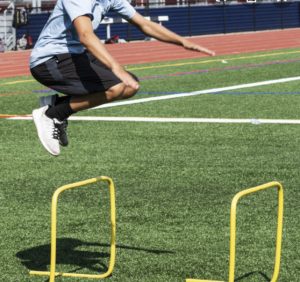Should young athletes get involved in plyometric training for increasing sports Performance? YES!!!!
CORE Physical Therapy In Omaha Explains…
By Dr. Mark Rathjen PT DPT CSCS
CORE Physical Therapy Co-owner
17660 Wright street sites 9/10
Omaha NE
402-933-4027

Plyometric training has been shown time and time again to be effective in increasing sports performance metrics in a multitude of sports and athletic populations. In this particular review, we are looking at youth soccer athletes in the mean age of 17 “The current evidence suggests that plyometric training should be completed 2 days per week for 8-10 weeks during soccer practice with a 72-hour rest period between plyometric training days. The initial number of foot contacts should be 50-60 per session and increase to no more than 80-120 foot contacts per session for this age group to prevent overuse injuries. A total of 3-4 plyometric training exercises should be performed 2-4 sets for 6-15 repetitions per training session. ”
I think it’s important for in season and out of season training parameters addressed in a future study. The ability to recover while practicing more skilled work for your sport is vital to performance. Also, off season strength training to ready the body for a PLYO schedule pre season is also ideal to build the hip and core strength for more explosive work for sports performance.
What does this mean to me as athlete?
- Schedule a pre season PLYO program to make sure you are ready for the power production work.
2. Stick to the plyo schedule and train it hard. Make sure a qualified professional designed and overseas your training. All training routines should be tailored to the athlete and the sport/position of play.
3. Enjoy your new ability to run, jump and sprint to new levels.
CORE Physical Therapy and Sports Performance clinicians can evaluate, prescribe and oversee all training programs and parameters. Purpose built programs for the athletes sport/position of play. Also, programs tailored to the athletes and specific strengths and weakness they may have is vital to injury prevention and optimal performance.
Check out our original Physical therapy clinic in Omaha.
17660 Wright St, Suites 9/10
Omaha, NE 68130
402-930-4027
At CORE Physical Therapy in Omaha, We specialize in the treatment of athletes. We have worked with athletes for a combined 30 years. CORE was established in 2015 by Dr. Mark and Dr. Claire Rathjen is family owned and operated.
We are proud to serve the greater Omaha metro area.
For More information, Please feel free to contact us http://coreomaha.com/contact/
Please feel free to follow us at https://www.facebook.com/COREomaha/
To get started http://coreomaha.com/getting-started/
For more Blog information http://coreomaha.com/blog/
Youtube Account linked below.
https://www.youtube.com/channel/UCVg8OSN5h-i1n_ykw1Gvahg?view_as=subscriber
Plyometric Training Effects on Athletic Performance in Youth Soccer Athletes: A Systematic Review
- PMID: 25756326
- DOI: 10.1519/JSC.0000000000000877
Abstract
The purpose of this systematic review was to critically analyze the literature to determine the effectiveness of plyometric training on athletic performance in youth soccer athletes. A total of 7 studies were included in this review after meeting the following criteria: (a) used plyometric training programs to assess athletic performance, (b) subjects were soccer athletes aged preadolescent up to 17 years, and (c) were published from 2000 to January 2014. Study methods were assessed using the PEDro scale with scores ranging from 4 to 6. Results showed similarities and differences in methodologies and procedures among the included studies. Athletic performance consisting of kicking distance, speed, jumping ability, and agility significantly improved because of plyometric training interventions. The current evidence suggests that plyometric training should be completed 2 days per week for 8-10 weeks during soccer practice with a 72-hour rest period between plyometric training days. The initial number of foot contacts should be 50-60 per session and increase to no more than 80-120 foot contacts per session for this age group to prevent overuse injuries. A total of 3-4 plyometric training exercises should be performed 2-4 sets for 6-15 repetitions per training session. The evidence and the literature suggest that plyometric training for this age group should only be implemented using recommended safety guidelines such as those published by the Canadian Society for Exercise Physiology and the National Strength and Conditioning Association and under appropriate supervision by trained personnel.
Similar articles
-
J Strength Cond Res. 2017 Dec;31(12):3295-3304. doi: 10.1519/JSC.0000000000002262.PMID: 29023331 Clinical Trial.
-
Plyometrics’ trainability in preadolescent soccer athletes.
J Strength Cond Res. 2013 Jan;27(1):38-49. doi: 10.1519/JSC.0b013e3182541ec6.PMID: 22450257 Clinical Trial. -
J Strength Cond Res. 2016 Dec;30(12):3278-3289. doi: 10.1519/JSC.0000000000001425.PMID: 27144955 Clinical Trial.
-
A systematic review: plyometric training programs for young children.
J Strength Cond Res. 2011 Sep;25(9):2623-33. doi: 10.1519/JSC.0b013e318204caa0.PMID: 21849911 Review. -
Sports Med. 2017 May;47(5):975-986. doi: 10.1007/s40279-016-0634-6.PMID: 27704484 Review.
